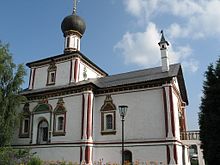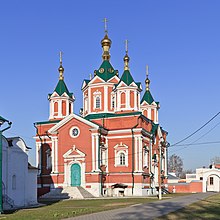Kolomna Kremlin
The Kolomna Kremlin ( Russian Коломенский кремль ) is a listed ensemble from the 16th century in the Russian city of Kolomna 110 km southeast of Moscow . It is a former city fortification similar to the Moscow Kremlin . The ensemble consists of parts of an enclosure wall with watchtowers as well as several historical buildings (including two monasteries ) that once lay within this wall.
history
Similar to the other Old Russian Kremlins south and south-east of Moscow (i.e. the Ryazan , Sarayisk and Tula Kremlin ), the Kolomna Citadel also served to secure the southern borders of the Moscow Grand Duchy , which in the course of its history was often the target of attack by the Crimean Tatars , for example . To protect the southern border, which ran a little further south of the river Oka , the so-called Verhaulinie was created. Several strategically particularly favorable locations were developed into fortress cities. One of these places was Kolomna, which is near the confluence of the Moskva and Oka rivers.
The construction of a city citadel based on the Moscow model began in May 1525, only a few years after Kolomna, which was then only protected by a wooden fortification, was attacked and burned by the Crimean Tatar troops of Mehmed I. Giray . It has not been passed down who the architects of the new Kremlin were, but it is suspected that Italian builders were involved - as in the construction of the Moscow Kremlin. After six years of construction, the new citadel was completed in August 1531.
Originally the Kremlin had 17 watchtowers that were built into a continuous enclosure wall up to 21 meters high. In terms of its area, the 24-hectare Kolomna Kremlin was only slightly smaller than its Moscow model (27.5 hectares). The fortress was located on the high bank of the Moscow River near the mouth of the Kolomenka River. Both this defensive location and the massive construction of the fortifications - during the construction, among other things, the abundant deposits of clay and limestone in the immediate vicinity of Kolomna were used - made the city extremely difficult to conquer. This became clear at the end of 1606 during the peasant uprising of Ivan Bolotnikov , who tried to storm the citadel without success.
In the course of the 17th century, when the southern borders of Moscow , which was now proclaimed Tsarist Russia, shifted further and further south, the defenses of the Verha line and with them the Kremlin of Kolomna lost their original meaning. In Kolomna in particular, trade and handicrafts developed from the middle of the 17th century, while the city fortifications were hardly maintained and increasingly fell into disrepair. Within the Kremlin wall as well as around the citadel a number of civil buildings were built, during the construction of which parts of the Kremlin wall were removed in order to gain bricks for construction. It was not until the 1820s that Tsar Nicholas I prohibited the demolition of the Kolomna Kremlin buildings by decree, although ten historical watchtowers and a large part of the wall had already been irrevocably destroyed by then.
The structures that are preserved today essentially reproduce the Kremlin ensemble in the 19th century. Some of the buildings built in the 18th and 19th centuries, which had to give way to the historical fortifications, are important architectural monuments of their time. Today, the Kremlin is considered the landmark of Kolomna.
Architecture and landmarks
The area of the Kremlin in Kolomna is around 24 hectares. The western section of the wall with two towers and five other towers are still standing today. The Kremlin wall, which in its original state was almost two kilometers long, is 18 to 21 meters high and three to 4.5 meters thick. The height of the watchtowers that have been preserved varies between 30 and 35 meters. Similar to Moscow, each tower has a historical name. Today two towers can be seen along the preserved western section:
- Facet Tower ( Грановитая башня )
- Marinkina Tower ( Маринкина башня )
The other five towers are located along the former southern section of the Kremlin wall:
- Pyatnitzkaya Tower ( Пятницкая башня ) - with a through gate
- Burnt tower ( Погорелая башня )
- Semyon Tower ( Семёновская башня )
- Ascension Tower ( Вознесенская башня )
- Jamskaya Tower ( Ямская башня )
A number of other architectural monuments are located directly on the former fortress area:
- The New Golutvin Monastery ( Ново-Голутвинский монастырь ) was originally a Russian Orthodox male monastery and was moved from the Kolomna suburb of Golutvin to the Kremlin at the beginning of the 19th century, where it has since been located in the building of the former bishop's residence. At the end of the 1980s, the monastery, which was closed in Soviet times, was returned to the Russian Orthodox Church and is now run as a women's monastery. The architectural ensemble of the New Golutwiner monastery which was built in the 17th century secular buildings of the former bishop's residence, the end of the 17th century are built Trinity Cathedral ( Троицкий собор ) and the neoclassical bell tower from the year 1825th
- The Brusenez Assumption Monastery ( Успенский Брусенский монастырь ) houses other valuable buildings on its site: The small Assumption Church ( Успенская церковь ) with a conspicuous tent roof was built in 1552 - just like the cathedral - like the cathedral of St. Dedicated to the conquest of the Kazan state by the army of Ivan the Terrible . The Cathedral of the Exaltation of the Cross ( Крестовоздвиженский собор ) was built in the 1850s in a historicist style that was widespread at the time, with allusions to the old Russian religious building traditions . Also striking is the decorative enclosure of the monastery with neat, pointed turrets as a visual addition to the Cathedral of the Exaltation of the Cross. The monastery was founded in 1552 and has been run as a women's monastery again since 1997.
- Similar to the Moscow Kremlin, the fortress in Kolomna also has a cathedral square ( Соборная площадь ), whose architectural dominant is the three-domed Cathedral of the Assumption ( Успенский собор ). It was built from 1672–1682 on the site of a church of the same name from 1379. The Church of Our Lady of Tikhvin ( Храм иконы Божией Матери Тихвинская ) with a tent-shaped bell tower has stood north of the cathedral since 1861, in the Russian historicist style .
- The Kolomna Kremlin is also home to a number of secular buildings from various periods. Even traditional Russian wooden houses have been preserved there; A sister of the famous writer Alexander Kuprin lived in one of them towards the end of the 19th century . Since the latter made several guest visits there and also worked on his manuscripts, the house is commonly referred to as the Kuprin House ( Дом Куприна ).
See also
literature
- Галина Вацлавна Длужневская, Владимир Александрович Калинин, Андрей Викторович Сужневская, Кремсандрович Калинин, Андрей Викторович Сукторович Субибовин : XV - XVII. Литера, Санкт-Петербург 2006, ISBN 5-94455-523-8 , pp. 168-173.
Web links
- Official website of the Kolomna Kremlin (Russian)
- Unofficial description with site plan (Russian)
- Website of the new Golutwin monastery (Russian, English )
Coordinates: 55 ° 6 ′ 14 ″ N , 38 ° 45 ′ 16 ″ E



